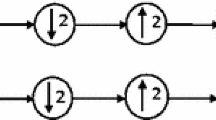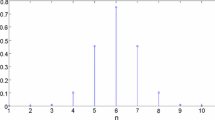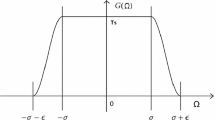Abstract
We present a novel eigenfilter-based approach to the design of time-frequency optimized, linear-phase, biorthogonal FIR filter banks. We first design a linear-phase, low-pass analysis filter, followed by a complementary linear-phase, low-pass synthesis filter. The optimality criterion used is uncertainty-based time-frequency localization, where the objective function is a convex combination of time variance and frequency variance of the respective filters. The objective function to be minimized is formulated in a convex-quadratic form and the perfect reconstruction (PR) and vanishing moment (VM) conditions are imposed in the eigen design of filters as a set of linear equality constraints. The PR and VM conditions are expressed in the time domain matrix formulation, so that these can directly be incorporated into the eigenfilter design. Using the Rayleigh principle, the optimal filter is obtained as an eigenvector corresponding to the minimum eigenvalue of the real symmetric positive-definite matrix associated with the optimization criterion. Thus, our formulation reduces the design problem of time-frequency optimal filter banks to an eigenfilter-based problem. Furthermore, the filter banks designed in this manner are found to be regular and are valid candidates for wavelet filter banks, allowing for the construction of linear phase wavelets. We present a few examples to show that the smooth wavelets can be constructed using the proposed method.





Similar content being viewed by others
References
L. Andrew, V.T. Franques, V. Jain, Eigen design of quadrature mirror filters. IEEE Trans. Circ. Syst. II: Analog Digital Signal Process. 44(9), 754–757 (1997)
E. Breitenberger, Uncertainty measures and uncertainty relations for angle observables. Found. Phys. 15(3), 353–364 (1985)
H. Caglar, Y. Liu, A.N. Akansu, Statistically optimized PR-QMF design. SPIE 1605(Visual Comm. and Image Proc’.91: Visual Comm.) 86–94 (1991)
A. Cohen, I. Daubechies, J.C. Feauveau, Biorthogonal bases of compactly supported wavelets. Commun. Pure Appl. Math. 45(5), 485–560 (1992)
T. Cooklev, A. Nishihara, M. Sablatash, Regular orthonormal and biorthogonal wavelet filters. Signal Process. (1997)
Z. Cvetkovic, M. Vetterli, Oversampled filter banks. IEEE Trans. Signal Process. 46(5), 1245–1255 (1998)
V. DeBrunner, J.P. Havlicek, T.P., Ozaydin, M., Entropy-based uncertainty measures for \(l^{2}\left(\mathbb{R}^{n}\right)\), \(l^{2}\left(\mathbb{Z}\right)\), and \(l^{2}\left(\mathbb{Z}/n\mathbb{Z}\right)\) with a hirschman optimal transform for \(l^{2}\left(\mathbb{Z}/n\mathbb{Z}\right)\). IEEE Trans. Signal Process. 53(8), 2690–2699 (2005)
D.L. Donoho, P.B. Stark, Uncertainty principles and signal recovery. SIAM J. Appl. Math. 49(3), 906–931 (1989)
D. Gabor, Theory of communication. Proc. Inst. Elec. Eng. 93(26), 429–441 (1946)
D.J. Griffiths, Introduction to Quantum Mechanics (Pearson Prentice Hall, 2005)
R. Guo, M. Sloderbeck, L. DeBrunner, M. Steurer, Real-time wavelet transform in an electric ship simulation. in 2011 IEEE Electric Ship Technologies Symposium (ESTS) (2011), pp. 463–467
R.A. Haddad, A.N. Akansu, A. Benyassine, Time-frequency localization in transforms, subbands, and wavelets: a critical review. Opt. Eng. 32(7), 1411–1429 (1993)
R.A. Horn, C.R. Johnson, Matrix Analysis. Cambridge University Press (1990)
R. Ishii, K. Furukawa, The uncertainty principle in discrete signals. IEEE Trans. Circ. Syst. 33(10), 1032–1034 (1986)
V. Jain, R. Crochiere, Quadrature mirror filter design in the time domain. IEEE Trans. Acoust. Speech Signal Process. 32(2), 353–361 (1984)
D. Monro, B.G. Sherlock, Space-frequency balance in biorthogonal wavelets. in Proc. Int. Conf. Image Process., 1997, vol. 1 (1997), pp. 624–627
J.M. Morris, H. Xie, Minimum duration-bandwidth discrete-time wavelets. Opt. Eng. 35(7), 2075–2078 (1996)
T. Nguyen, P. Vaidyanathan, Two-channel perfect-reconstruction FIR QMF structures which yield linear-phase analysis and synthesis filters. IEEE Trans. Acoust. Speech Signal Process. 37(5), 676–690 (1989)
R. Parhizkar, Y. Barbotin, M. Vetterli, Sequences with minimal time-frequency uncertainty. arXiv preprint arXiv:1302.2082 (2013)
B. Patil, P. Patwardhan, V. Gadre, Eigenfilter approach to the design of one-dimensional and multidimensional two-channel linear-phase FIR perfect reconstruction filter banks. IEEE Trans. Circ. Sys. I 55(11), 3542–3551 (2008)
S.C. Pei, C.C. Tseng, W.S. Yang, FIR filter designs with linear constraints using the eigenfilter approach. IEEE Trans. Circ Syst. II: Analog Digital Signal Process 45(2), 232–237 (1998)
S.M. Phoong, C. Kim, P. Vaidyanathan, R. Ansari, A new class of two-channel biorthogonal filter banks and wavelet bases. IEEE Trans. Signal Process. 43(3), 649–665 (1995)
T. Przebinda, V. DeBrunner, M. Ozaydin, Using a new uncertainty measure to determine optimal bases for signal representations. in Proc. IEEE Int. Conf. Acoust. Speech Signal Process. ICASSP ’99, vol. 3 (1999), pp. 1365–1368
M. Sharma, R. Kolte, P. Patwardhan, V. Gadre, Time-frequency localization optimized biorthogonal wavelets. in Int. Conf. on Signal Process. and Comm. (SPCOM), 2010 (2010), pp. 1–5
D. Slepian, Prolate spheroidal wave functions, fourier analysis, and uncertainty. V—The discrete case. AT & T Tech. J. 57, 1371–1430 (1978)
G. Strang, Eigenvalues of \((\downarrow 2)\) H and convergence of the cascade algorithm. IEEE Trans. Signal Process. 44(2), 233–238 (1996)
D.B. Tay, Balanced-uncertainty optimized wavelet filters with prescribed regularity. in Proc. IEEE Int. Symp. Circ. Syst. ISCAS ’99, vol. 3 (1999), pp. 532–535
D.B. Tay, Rationalizing the coefficients of popular biorthogonal wavelet filters. IEEE Trans. Circ. Syst. Video Tech. 10(6), 998–1005 (2000)
D.B. Tay, Balanced-uncertainty optimized wavelet filters with prescribed vanishing moments. Circ. Syst. Signal Process. 23(2), 105–121 (2004)
A. Tkacenko, P. Vaidyanathan, T. Nguyen, On the eigenfilter design method and its applications: a tutorial. IEEE Trans. Circ. Syst. II: Analog Digital Signal Proces. 50(9), 497–517 (2003)
P.P. Vaidyanathan, Multirate Systems and Filter Banks. Prentice-Hall Signal Processing Series. (Prentice Hall, Englewood Cliffs, 1993)
P. Vaidyanathan, P.Q. Hoang, Lattice structures for optimal design and robust implementation of two-channel perfect-reconstruction QMF banks. IEEE Trans. Acoust. Speech Signal Process. 36(1), 81–94 (1988)
M. Vetterli, C. Herley, Wavelets and filter banks: theory and design. IEEE Trans. Signal. Process. 40(9), 2207–2232 (1992)
R. Wilson, Uncertainty, eigenvalue problems and filter design. in IEEE Int. Conf. Acoust. Speech Signal Process. ICASSP ’84, vol. 9 (1984), pp. 164–167
R. Wilson, G.H. Granlund, The uncertainty principle in image processing. IEEE Trans. Pattern Anal. Mach. Intell. PAMI 6(6), 758–767 (1984)
R. Wilson, M. Spann, Finite prolate spheroidal sequences and their applications. II. Image feature description and segmentation. IEEE Trans. Pattern Anal. Mach. Intell. 10(2), 193–203 (1988)
H. Xie, J.M. Morris, Design of orthonormal wavelets with better time-frequency resolution Proc. SPIE Conf, Wavelet Applications, Orlando, FL (1994), pp. 878–887
Acknowledgments
The authors acknowledge the support received from Bharti Center for Communication, Department of Electrical Engineering, Indian Institute of Technology, Bombay and Acropolis institute of technology and research, Indore toward the research work presented in the manuscript.
Author information
Authors and Affiliations
Corresponding author
Appendices
Appendix
Derivation of Matrix Formulation for Time and Frequency Variance for Real Symmetric Discrete-Time Sequences
1.1 Frequency Variance Measure
From the Eq. (31) the frequency variance of the zero phase, low-pass, real FIR filter \(h(n)\) of length \(2N+1\), \(N\in \mathbb {N}\) is given by
where the matrix \(\mathbf {Q}\) and the vector \(\mathbf {a}\) are defined in the Eqs. (31) and (26), respectively. We define the matrix \(\mathbf {E}\) as
The matrix \(\mathbf {E}\) can also be expressed as follows:
The vector \(\mathbf {c}(\omega )\) is defined in (27). The \((k,l)^{th}\) element of the matrix \(\mathbf {E}\) is given as
where \(0 \le k,l \le N\). The matrix \(\mathbf {Q}\) corresponding to the frequency variance is related to the matrix \(\mathbf {E}\) as
The \((k,l)^{th}\;\text{ element }\) of the matrix \(\mathbf {Q}\) can be given as
In order to evaluate the integrals in the Eq. (56), we substitute \(k+l=m\) and \(k-l=s\). Thus (56) boils down to
The indefinite integral \(I=\int \omega ^{2}\cos (m\omega )d\omega \) is evaluated as
On substituting limits in the integral of the expression (58) we get
Using (59), (57), and (55), we obtain
where \(0\le k,l\le N\).
1.2 Time Variance Measure
From the Eq. (34) the time variance of the zero phase, low-pass, real FIR filter \(h(n)\) of length \(2N+1\), \(N\in \mathbb {N}\) is expressed as
where the matrix \(\mathbf {P}\) and the vector \(\mathbf {a}\) are defined in the Eqs. (34) and (26), respectively. We define the matrix \(\mathbf {F}\) as
The vector \(\mathbf {f}(\omega )\) is defined in (28). The \((k,l)^{th}\) element of the matrix \(\mathbf {F}\) is given as
The matrix \(\mathbf {P}\) corresponding to time variance is related to the matrix \(\mathbf {F}\) as
The \((k,l)^{th}\) element of matrix \(\mathbf {P}\) is
In order to evaluate the integral in the Eq. (63), we substitute \(k+l=m\) and \(k-l=s\). Thus (63) boils down to
The value of the integral \(\frac{1}{\pi }\int _{0}^{\pi }\cos (m\omega )d\omega \) is evaluated as
Thus, the matrix \(\mathbf {P}\) can be expressed as
It is to be noted that the matrix \(\mathbf {P}\) can be obtained directly using (5) in time domain; however, for the sake of completeness we derived the matrix \(\mathbf {P}\) using frequency-domain approach and Parseval’s identity.
Rights and permissions
About this article
Cite this article
Sharma, M., Gadre, V.M. & Porwal, S. An Eigenfilter-Based Approach to the Design of Time-Frequency Localization Optimized Two-Channel Linear Phase Biorthogonal Filter Banks. Circuits Syst Signal Process 34, 931–959 (2015). https://doi.org/10.1007/s00034-014-9885-3
Received:
Revised:
Accepted:
Published:
Issue Date:
DOI: https://doi.org/10.1007/s00034-014-9885-3




